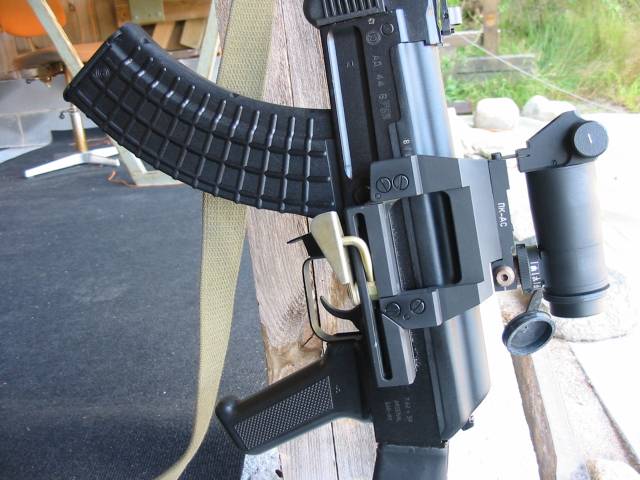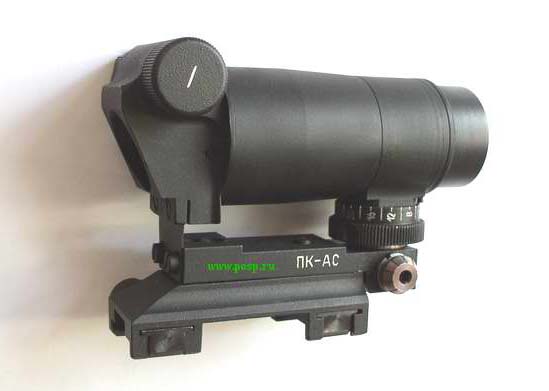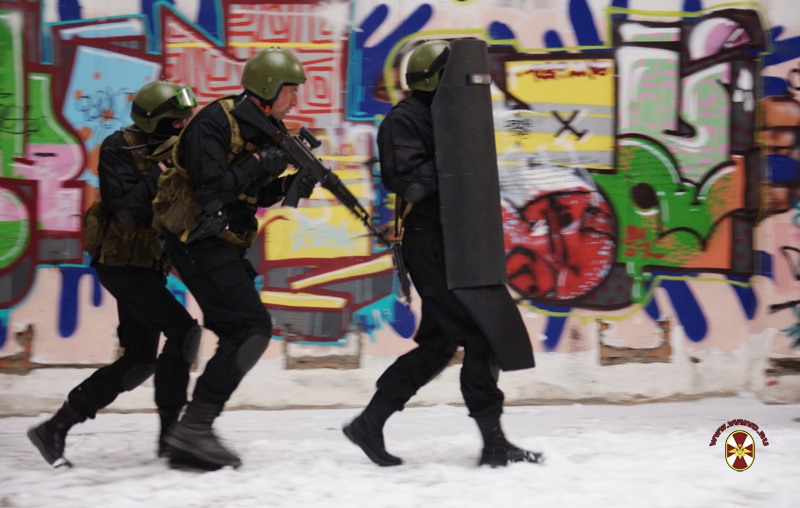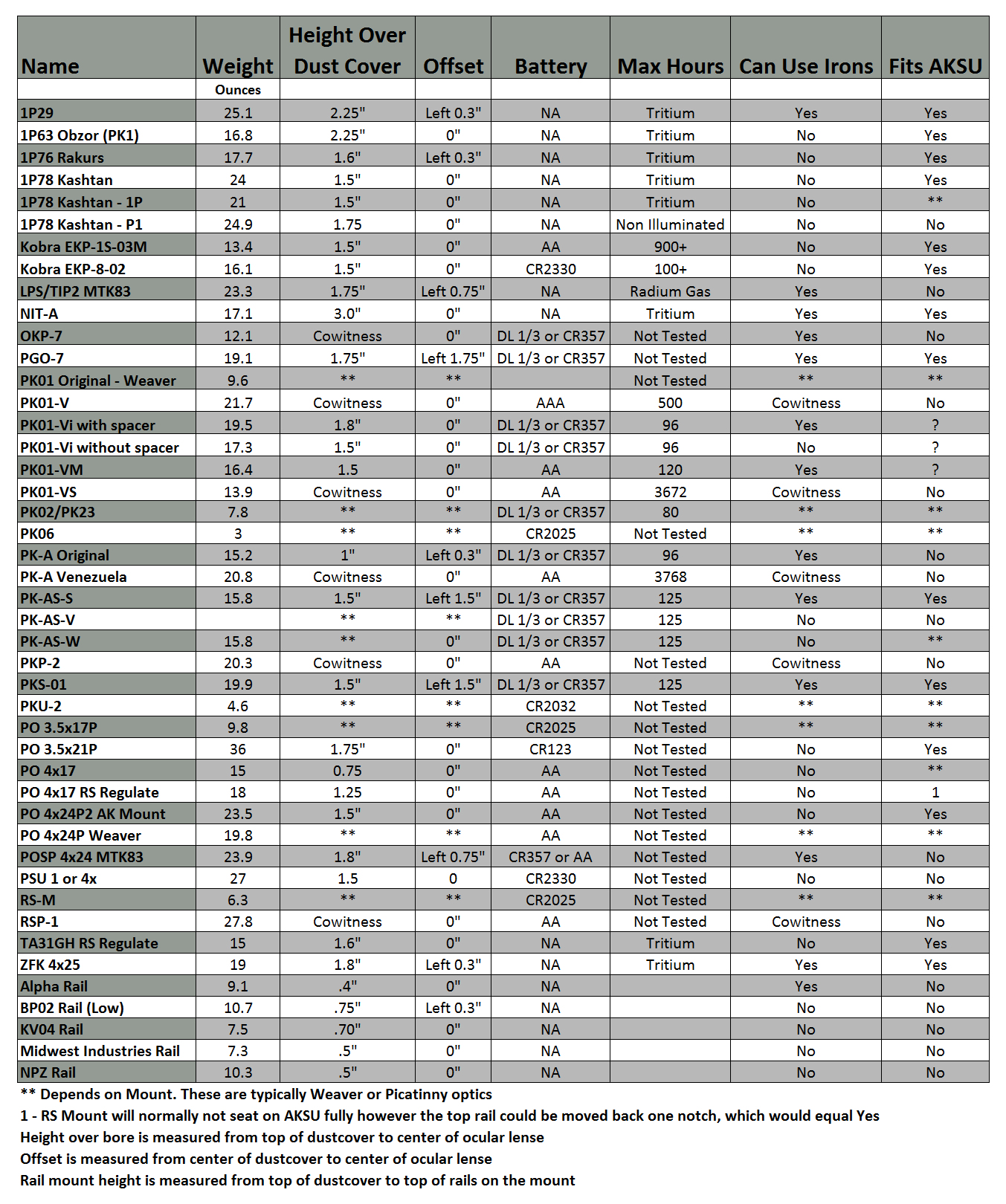A long time favorite of mine, the PK-AS is an
interesting and well designed collimator sight that
has probably the best field of view of any red dot or
collimator type optic that I've seen. Originally
descended from the PKS-07 magnified scope used on the
SV98 and sometimes SVD Dragunov rifles, the PK-AS is
the non magnified version inspired from the original
PKS-01.
Of all the collimators I have personally used it
seems to me that PK-AS has the highest light gathering
and clearest optical quality. Due to it's construction
and with such a thin scope body the edges almost
completely disappear with both eyes open, leaving you
with virtually nothing to obscure your vision. A small
1.5moa always on black dot is handy for more precise
shooting and a large black oval is useful for CQB
shooting. The PK-AS dot can be illuminated red for low
light/night shooting and uses common CR357 type watch
batteries, and has a variable intensity as part of the
on/off knob. Battery life at max brightness is about 120
hours. Only the dot illuminates, not the oval as
well.
This is the most difficult Russian optic to zero
due to the mechanical nature of the windage and
elevation controls and this is actually an intentional
part of the design. PK-AS was intended to be zeroed to
a specific rifle and to remain paired with that rifle,
therefore the ability to easily re-zero in the field
did not appear to be necessary.
KalinkaOptics
has a manual for the PK-AS that
explains the features in detail, as well as how to
zero. Having experience with it I can say it's not too
difficult once you get the hang of it but it's really
not the easiest thing for a first time user.
PK-AS comes with a 3.5mm wrench for adjustment
From Avtomats-In-Action

This is also one of the most left offset optics and
has a reputation for not giving a good cheekweld. If
you are right eye dominant I think this is true,
however with both eyes open you can still get somewhat
of a chinweld. It's definitely to the left however and
can be tough for new shooters to get used to. Because
of the offset PK-AS does not block the irons, but the
AK version with MTK83 mount does. The AK version sits
higher than regular PK-AS however and that may take
some getting used to as well. My personal experience
was that I had to train with this optic to get used
to, it wasn't as natural as other rifle/optic
combinations I'd tried but as I learned to shoot with
both eyes open and practiced more close range drills I
began to get an idea of why it was designed the way it
was. After you spend some time with it it becomes easy
to use and I continue to respect the PK-AS, but all
things considered I think Rakurs is probably the
better of the two.
PK-AS has an elevation cam wheel graduated in 2
MOA increments that can be used for any caliber rifle
if you know your ballistic drop at range. I believe
the pure military version of the PK-AS elevation cam
is in meters but I have not verified this in person.
Suffice to say that it can be easily used out to 400m
by applying the standard 22cm offset of the 400m zero
principle, allowing you to put the dot on center mass
and not have to know or adjust for range out to about
400 meters.
PK-AS is descended from PKS-01, which itself is a
descendant of the PKS-07 shown here on an NDM86.
PKS-07 is a 7x sniper optic for the SV98 rifle but is
effective on the SVD as well.
PK-AS with PKS-07
Left PK-AS and right, the original PKS-01. This
version of PKS-01 is actually for the AS Val,
a suppressed 9x39 rifle.
The PK-AS uses a universal mount, PKS-01 (as currently
available in the US) uses an SVD mount for the AS-Val.
There are dedicated 5.45x39 military versions of
PKS-01 but I have not seen them yet.
SVD stop pin on the front part of PKS-01 (right)
and Universal mount on the PK-AS (left)
PK-AS comes in several variants as well including
a Weaver mount and a civilian model with an MTK83 AK
mount that sits directly over the bore (and higher
than the regular PK-AS)
PK-AS-V with MTK83 AK mount. This makes the PK-AS very
tall and uncomfortable for some shooters.
This was my favorite collimator / red dot for many
many years and probably would still be if it were not
for the appearance of the Rakurs and most recently
Obzor. I'm a big fan of the always on black dot which
means that even if the batteries go dead you still
have the ability to use the optic during the day.
While Rakurs looks huge next to PK-AS the two are
about very close in weight...17.1 ounces for Rakurs vs
15.8 for PK-AS
An excellent question from AR15.com member
Robotizing. This was my response on how to zero the
optic
Because of how many optics I fool around with I use a
pretty simple method which is to always move the
reticule to the bullet impact. I can never keep track
of trajectory right/trajectory left because so many
are opposite of each other and for me making a large
reticule movement helps me remember which way is which
with just a couple shots. That makes it easy to zero a
bunch of different optics in one trip.
Having said that for the PK-AS it's not too
complicated to understand because it's a
straightforward mechanical system that moves the scope
body in order to move the reticule. The tricky part is
how the three screws control the axis of the reticule
and does take some familiarization. This is why I
always say that the PK-AS is the hardest to zero of
all the optics I've come across yet but it's not a
deal killer since you typically only have to do it
once for the rifle in question.
Unloosen the left side locking nut using a 3.5mm allen
wrench. You will find that to make adjustments while
the PK-AS mounted you will need to remove your dust
cover to get into the screws. The W or V versions may
need to be removed from the rifle completely.
For windage the right side screw turns clockwise which
pushes on the center shaft. This causes the reticule
to move to the right because the windage screw is
screwing in deeper. To move the reticule to the left
unscrew by turning counter clockwise...this brings the
windage screw further out of the optic.
For elevation the bottom screw goes deeper into the
optic (headed up, or away from the receiver) which
causes the reticule to move down. Clockwise and
counterclockwise is somewhat hard to describe because
of the positioning of the screw and optic but I'll
try. If you are looking forward to the muzzle from the
back of the rifle as though you are sighting down the
scope the allen wrench should move from the left side
of the rifle to the right side.
If you are looking down on the optic from above and
behind the rifle, the allen wrench should turn counter
clockwise...again the wrench will visibly move from
the left side of the rifle to the right as you swing
through a half turn (which is all you can do because
of the restricted range of motion from the mount
itself).
The range wheel acts in a similar fashion. When
viewing from above clockwise causes the reticule to
move up, counterclockwise causes the reticule to move
down. When the reticule moves up the lowest numbers
will be showing when the range wheel stops. When the
reticule has moved the furthest down that it can
highest numbers are showing. What this means is that
after the weapon is zeroed, moving the reticule down
will make the trajectory go higher which compensates
for range. When the reticule has been brought down as
far as it will go in the FOV the range wheel will have
the highest numbers showing...either the largest MOA
that be applied for most versions, or the furthest
distance for the few that have miltary range
increments.
What is tricky about the PK-AS is that the locking nut
also acts as the stop for the windage nut and the
pressure when the two meet during tightening after
zero can throw the zero off slightly. It's not
uncommon for me to have to refine the zero because the
locking nut pushes the windage nut further out which
causes the reticule to move left slightly. It can be a
bit of dance but with patience you'll get a feel for
how tight the locking nut needs to be screwed in to
minimize this effect.
PK-AS is in use with police and counter terrorist
units but has not been adopted by the Russian military
so far as I know at this time.




